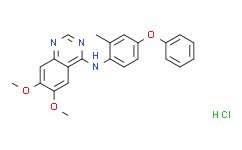| Cas No.: | 2002381-31-7 |
| Chemical Name: | APS-2-79 hydrochloride |
| Synonyms: | APS-2-79 (hydrochloride);APS 2-79 hydrochloride;6,7-Dimethoxy-N-(2-methyl-4-phenoxyphenyl)quinazolin-4-amine hydrochloride;APS279 hydrochloride;BCP23567;s8355;AK685587;6,7-dimethoxy-N-(2-methyl-4-phenoxyphenyl)quinazolin-4-amine HCl;APS-2-79 hydrochloride |
| SMILES: | Cl[H].O(C1C([H])=C([H])C([H])=C([H])C=1[H])C1C([H])=C([H])C(=C(C([H])([H])[H])C=1[H])N([H])C1C2=C([H])C(=C(C([H])=C2N=C([H])N=1)OC([H])([H])[H])OC([H])([H])[H] |
| Formula: | C23H22ClN3O3 |
| M.Wt: | 423.8921 |
| Sotrage: | 2 years -20°C Powder, 2 weeks 4°C in DMSO, 6 months -80°C in DMSO |
| Description: | APS-2-79 hydrochloride behaves as a kinase suppressor of Ras (KSR)-dependent antagonist of RAF-mediated MEK phosphorylation. APS-2-79 binds directly to KSR2 within the KSR2-MEK1 complex with an IC 50 of 120±23 nM for KSR2. |
| In Vitro: | APS-2-79 (1 μM) shifts the cell viability dose response to Trametinib in Ras-mutant cell lines HCT-116 and A549, but not BRAF mutant cell lines SK-MEL-239 and A375. Although the cellular effects of APS-2-79 alone are modest, combination analysis over full concentration matrices reveal that kinase suppressor of Ras (KSR)-inactive state (KSRi) synergizes with Trametinib, and other MEK inhibitors, specifically in KRAS mutant cell lines. APS-3-77, and additional control compounds, do not demonstrate Ras-mutant-specific synergy, supporting the hypothesis that the enhanced activity of Trametinib when combined with APS-2-79 depends on co-modulation of KSR[1]. |

 DC Chemicals' products qualify for U.S. tariff exemptions. We guarantee no price increases due to customs duties and maintain stable supply, continuing to deliver reliable research solutions to our American clients.
DC Chemicals' products qualify for U.S. tariff exemptions. We guarantee no price increases due to customs duties and maintain stable supply, continuing to deliver reliable research solutions to our American clients.





















